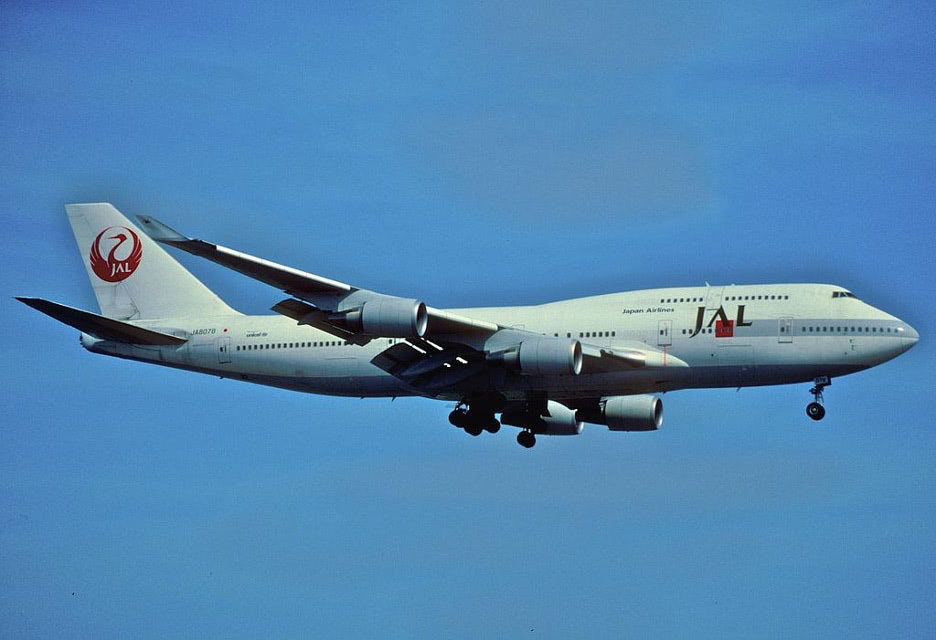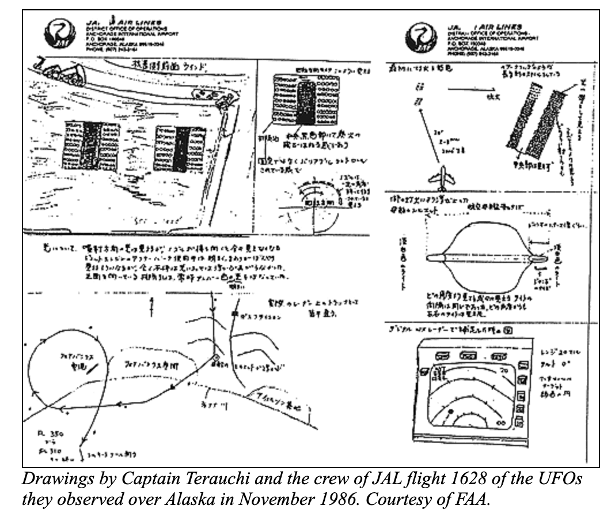Summary

On the night of November 17, 1986, Japan Airlines Boeing 747 cargo flight JAL1628 was en route from Paris to Tokyo. As it neared the end of the route, its flight crew saw and tracked three unidentified lighted objects that were keeping pace with their aircraft. According to Captain Kenju Terauchi, First Officer Takanori Tamefuji, and Flight Engineer Yoshio Tsukuda they saw two small lights and a gigantic round object the size of an aircraft carrier with flashing colored lights, which remained on their radar for over 30 minutes, as they flew 350 miles southward across from Ft. Yukon, Alaska toward Anchorage.¹
The Alaskan Incident, as it was later referred to by the media, was remarkable for involving a prolonged and dramatic close encounter by highly credible witnesses that were corroborated by multiple radar systems that included Federal Aviation Authority (FAA) and U.S. military ground radar. Terauchi, an ex-fighter pilot with more than 10,000 hours flight experience and over 29 years of service, was one of JAL’s most experienced pilots, and has never recanted his testimony despite subsequent stigma. The incident is also one of many sightings where the unknown object seemed to affect wireless equipment, in this case the plane’s radio communications.
The Sighting
Terauchi, sitting on the left side of the cockpit, first saw the unidentifiable lights out his side window. While the sky to the right had an afterglow of sunset, ahead and to the left it was dark except for the lights.
At first, he ignored the lights given the flight’s location since the US Air Force maintained continual air surveillance over Alaska at the time due to its proximity to the former Soviet Union. He then noticed that the position of the lights had not changed even after a few minutes. The lights appeared to be traveling along with his plane.²
In his written testimony, Terauchi speculated that the "spaceships" fired jets to kill the inertia of their high speed maneuver and stopped right in front of them.
"Most unexpectedly two spaceships stopped in front of our face, shooting off lights," wrote Terauchi. “The inside cockpit shined brightly and I felt warm in the face.”³
Terauchi grabbed his camera to try to take a picture, but could not get it to focus, as the lights began moving strangely, which prevented him from capturing a clear image.

During his FAA interviews, Terauchi was asked to describe the type of radio interference he heard. He described the interference as "some kind of, like, ah, jamming... it was just a noise, it sounded like zaa, zaa.” The communications capability was at two out of five, he said, with five being perfectly clear.
Throughout the incident, both the flight crew and Air Route Traffic Control Centers (ARTCC) were able to track the object on radar. Tsukuda picked up the objects on the plane’s weather radar system and watched for roughly 10 minutes, and noted that its radar target movements corresponded perfectly with the crew’s cruise visual observations.⁴ About five minutes after the objects first appeared in front of the cockpit and eventually darted off.
At this point, Terauchi saw two pale white lights on the horizon. Terauchi believed that the lights were anchored to a larger object, which he later called “the mothership.”⁵ The large object was silhouetted against the dark sky. He could tell that it was walnut shaped with a wide rim around its circumference.
Callahan Investigation
John Callahan was the FAA Division Chief of the Accidents and Investigations Branch in Washington, D.C.. Callahan investigated the JAL 1628 incident, and studied the audio tapes from air traffic control.
Callahan came forward to present members of the FBI, CIA, and three people from President Ronald Reagan’s scientific study team a briefing on the incident.
Callahan recalled this exchange:
“When they got done, they actually swore all these other guys into, ‘This never took place. We never had this meeting, and this was never recorded.’ This was one of the guys from the CIA. I asked them at the time, ‘I don’t know why you’re saying this. I mean, if there was something there and if it’s not the [then in development] Stealth Bomber, then you know it’s a UFO. And if it’s a UFO, why wouldn’t you want the people to know?’ He said if they come out and told the American public that they ran into a UFO out there, it would cause panic across the country. So therefore, we can’t talk about it. And we’re taking all this data…
When they asked me what I thought, I told them that it looked like we had a UFO that was up there. As far as I was concerned, Reagan’s science team were the ones that verified my own thoughts about it. They were very, very excited about the data. They had said at that time that this was the only time — and they had used the words ‘a UFO’ — was ever recorded on radar for any length of time.”⁶
The public relations strategy in dealing with the incident was that the FAA “had nothing to hide.”⁷
The Aftermath
The U.S. media picked up on the story, and the incident spread across national newspapers. UPI reporter Jeff Berliner broke the story in the United States on December 29, and then numerous newspapers reprinted the story. At this point, the Anchorage press office reached out to FAA headquarters in Washington, D.C. to inquire how to handle the press interest in the UAP. In a Washington Post article on January 1, 1987, it cited the FAA’s interest in the case, and they would be conducting an investigation, as a response to the Anchorage Air Route Traffic Control Center’s report that the UAP had been detected on radar.⁸ Paul Steucke, FAA spokesman at Anchorage, cited a “lack of scientific”⁹ investigation to pursue further investigation.
Terauchi became a public figure, featured on numerous radio and TV programs and in People Magazine. In interviews, he described the objects as “two small ships and the mothership” and noted their extraordinary rates of acceleration and deceleration.
Within months of the sighting, Terauchi was demoted to a desk job because he had “embarrassed” the company.¹⁰
On January 29, 1987, the London Times reported a tip from renowned UAP debunker Philip Klass, who had just retired from his editorial position at Aviation Week & Space Technology. Klass claimed that the lights the pilot saw were actually a bright Jupiter or Mars.¹¹
The FAA continually changed its public stance on the matter as the months progressed. At first they confirmed the claims that several of its radar traffic controllers tracked the 747 and the large object, and that U.S. Air Force radar did as well. Later officials tried to ascribe the radar targets to weather effects. Official statements became increasingly negative as the days passed, casting doubt on the radar confirmation of the visual observations. At a press conference held by the FAA on March 5, 1987,Steucke stated: "As far as we know, the whole crew are people of integrity and did report what they saw accurately."¹²